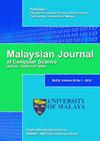VISUALIZATION WITH VOCABULARY TRACKING FOR ARABIC WORD RECOGNITION AND READING COMPREHENSION
IF 1.2
4区 计算机科学
Q4 COMPUTER SCIENCE, ARTIFICIAL INTELLIGENCE
引用次数: 1
Abstract
Comprehending text is the aim of reading; however, there is the phenomenon of non-Arabic speakers in Malaysia reading the Qur’an, written in Arabic, without comprehension. Word recognition (WR) theory, through word frequency effect (WFE) and word superiority effect (WSE), are used as a basis to achieve reading comprehension (RC) of the Qur'an. The Eye of Qur'an (EoQu) interface was developed, to visualise word occurrences and word morphology. This is achieved through parallel plot and word segmentation visualization. EoQu can track a user’s personal vocabulary with a presentation of percentage and word position in the Qur’an. Consequently, users know their ability to recognize Arabic words in relation to the whole Qur’an to achieve RC. An experimental study was set up with 90 Malaysian participants, starting with a pre-test, followed by a stratified sampling to divide participants into control and experimental groups (who used EoQu) for the post-test. Results showed evidence of improvement in WR based on scores and time taken to complete the Arabic Word Recognition Test.可视化与词汇跟踪阿拉伯语单词识别和阅读理解
理解文本是阅读的目的;然而,在马来西亚,非阿拉伯语使用者在阅读用阿拉伯语写成的《古兰经》时却无法理解。单词识别理论通过单词频率效应(WFE)和单词优势效应(WSE)作为实现《古兰经》阅读理解的基础。古兰经之眼(EoQu)界面被开发出来,用于可视化单词的出现和单词的形态。这是通过平行绘图和分词可视化实现的。EoQu可以通过在古兰经中的百分比和单词位置来跟踪用户的个人词汇。因此,用户知道他们识别与整个《古兰经》相关的阿拉伯语单词的能力,以实现RC。对90名马来西亚参与者进行了一项实验研究,从预测试开始,然后进行分层抽样,将参与者分为对照组和实验组(使用EoQu)进行后测试。结果显示,根据完成阿拉伯语单词识别测试的分数和时间,WR有改善的证据。
本文章由计算机程序翻译,如有差异,请以英文原文为准。
求助全文
约1分钟内获得全文
求助全文
来源期刊

Malaysian Journal of Computer Science
COMPUTER SCIENCE, ARTIFICIAL INTELLIGENCE-COMPUTER SCIENCE, THEORY & METHODS
CiteScore
2.20
自引率
33.30%
发文量
35
审稿时长
7.5 months
期刊介绍:
The Malaysian Journal of Computer Science (ISSN 0127-9084) is published four times a year in January, April, July and October by the Faculty of Computer Science and Information Technology, University of Malaya, since 1985. Over the years, the journal has gained popularity and the number of paper submissions has increased steadily. The rigorous reviews from the referees have helped in ensuring that the high standard of the journal is maintained. The objectives are to promote exchange of information and knowledge in research work, new inventions/developments of Computer Science and on the use of Information Technology towards the structuring of an information-rich society and to assist the academic staff from local and foreign universities, business and industrial sectors, government departments and academic institutions on publishing research results and studies in Computer Science and Information Technology through a scholarly publication. The journal is being indexed and abstracted by Clarivate Analytics'' Web of Science and Elsevier''s Scopus
 求助内容:
求助内容: 应助结果提醒方式:
应助结果提醒方式:


